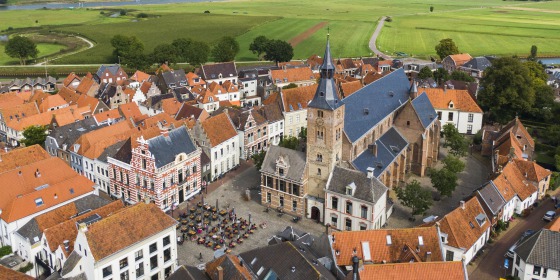Hattem Hanseatic Town
- Reading time 4 minutes
- 1721 x bekeken
In the Middle ages, when Amsterdam and Rotterdam were still tiny villages, the Hanseatic towns in the eastern parts of the Netherlands had already developed into powerful centres of commerce. The economic heart of the Netherlands was beating on the river IJssel, the Zuiderzee and the hinterland. In the Hanseatic towns the economy was thriving and booming!
Small settlements grew into powerful cities with impressive city walls and archways. The affluence could be spotted in imposing buildings, elegant merchant houses and impressive trade offices. It also led to an artistic golden age. Painters, poets and philosophers settled in the town. For centuries Hattem has been a source of inspiration for artists. This is not very surprising: the town is not only ‘’photogenic’’, it is also situated in splendid surroundings with woods and water on its doorstep. The location of Hattem on the river IJssel guarantees a free view from there on the famous Dutch skies.
Beginning of the Hanseatic League
Around 1150 the Hanseatic League started when travelling German merchants began to participate in trade on the Baltic Sea. These groups of merchants were called Hansa. The objective was trading freely and quietly far away from home.
The Hanseatic League becomes a town alliance
The Hanseatic League of merchants could acquire favourable privileges by combining their interests. Moreover, together they strengthened their position versus the feudal lords. Exchanging knowledge and information was an important side effect. The first town alliance dates from 1265 between Lübeck and Rostock. In 1294 Zwolle joined as the first Dutch town. In its heyday the Hanseatic League had members in Germany and the Netherlands but also in Scandinavia, Poland, Flanders up to Spain and Portugal. Language was not too much of a problem, everyone could manage with Low German or Diets.
Trade by water
Important trading routes ran from the Baltic Sea to western Europe and from Italy to Norway via Cologne and the river IJssel. Transport by sea took place mainly by the first cargo vessels of the Middle Ages: the ‘’Cogs’’. Trade wares were mainly salt, fish, cereals, wood, beer, wine, linen, beeswax and pelts.
Principal towns and “bijsteden’’ or secondary towns
Lübeck was head of the Hanseatic League . The Hanseatic meetings were held there. Some 70 principal towns attended the meetings. Besides those there were bijsteden – secondary towns -which made use of the privileges of the Hanseatic League but had no voting rights in the meetings. They were represented by their principal town. Hattem together with Wageningen was a bijstad of principal town Arnhem. This was caused by the fact that Hattem and Wageningen acquired the same town rights as Arnhem.
The role of Hattem in the Hanseatic League↵ In the archives it is hard to find evidence of the role Hattem played in the League. That is not surprising: Hattem is not comparable to large trading towns such as Kampen, Zwolle and Deventer. Merchants from Hattem are only mentioned twice in the town archives: in 1306 and in 1485.
Bricks
What did Hattem have to offer to the merchants of the League? One speculative possibility is the idea that bricks from Hattem were taken on board by boatmen as necessary counterweight. They rather took bricks than sand because bricks still retained their value. Many sources prove that brick from Hattem was traded across water.
Harbour and alleyways to the Market
Hattem had a few jetties on the waterfront which functioned as ‘’harbour’’. In those days there may very likely have been a wall connecting the Schipperswal to the Dijkpoort. In that wall there may have been entrances opposite the 1st and 2nd Steeg (alleyway). Those were the shortcuts to the Market. In many other Hanseatic towns more alleyways between harbour and market can be found than elsewhere in the town.



